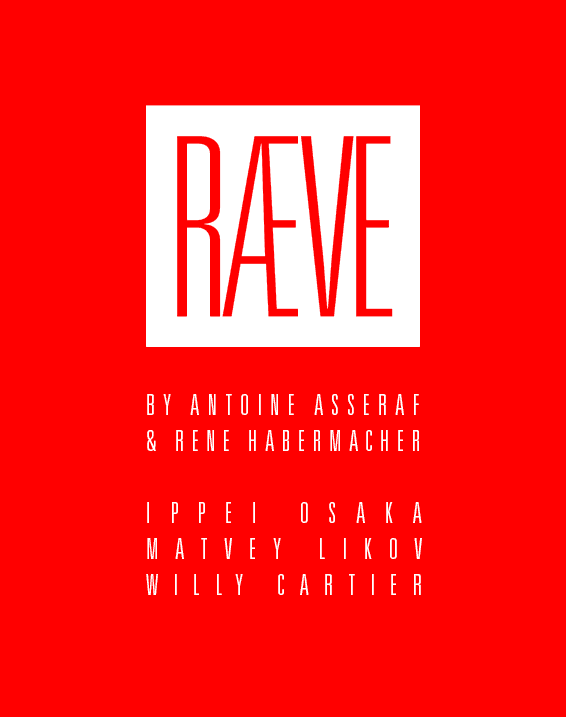-

not lost : ræve
-Once upon a time, we made a fashion film shoot with some of the best men’s designs around.
Givenchy, Raf Simons, Ann Demeulemeester, Rick Owens, Gareth Pugh, Comme des Garçons…we had it all. We also had a great concept (think butoh meets inception), a fantastic cast (Ippei is an amazing butoh performer, while Matvey and Willy, both top men’s models, would film Woodkid’s IRON video a few days later), great hair and great make-up, everything great.
RAEVE stroke-inducing poster by Clément Roncier.
Only problem was, we never really found the time to edit it.
Until now.
So without further ado, ræve.
RAEVE
by Antoine Asseraf & René Habermacherstarring Ippei Hosuka + Willy Cartier @ Success Paris + Matvey Lykov@ Success Paris
styling Jean-Luc Française / photo assistant Laurent Dubain / styling assistant Tiphaine Menon / hair Tanya Koch @ B Agency /make-up Akiko Sakamoto / studio Le Petit Oiseau Va Sortir
editing Axelle Zecevic / Clément Roncier / postproduction Clément Roncier / music Oedo Sukeroku “Shunrai” + John Cage “Sonata V” / special thanks Jean-Marc Locatelli
00 -

dimitris papaioannou : the wandering kouros
-THE WANDERING KOUROS
In the last part of our conversation Dimitris Papaioannou speaks about his current project INSIDE that premieres in April at the Pallas Thatre in Athens
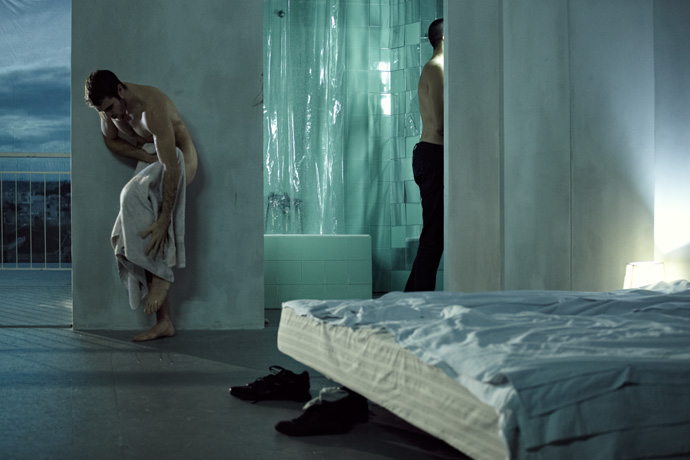 Scene from INSIDE by Dimitris Papaioannou. Photo by René Habermacher
Scene from INSIDE by Dimitris Papaioannou. Photo by René Habermacher
RENE HABERMACHER: Let’s speak a little about your new play: INSIDE.DIMITRIS PAPAIOANNOU: INSIDE is a work born where two situations come together. The first is a show that runs endlessly without beginning, middle or end. The second is a situation in which audiences are allowed to visit at any time they like, sit wherever like, and are free to leave and return as many times as they like. The theatre doors open at 17:30 and close at 23:30. The stage action begins before you come in, and continues after you leave. Nobody sees a beginning, or an end. The play recycles itself, but never repeats itself.
We are playing with the concept of empty time. INSIDE focuses on personal time, that series of moments we experience when we return home. In a way it monumentalises these moments: the very fact of eating, or the very fact of showering, or the very fact of undressing to go to sleep. And without any assistance from civilisation — without a book, a magazine, radio or television.
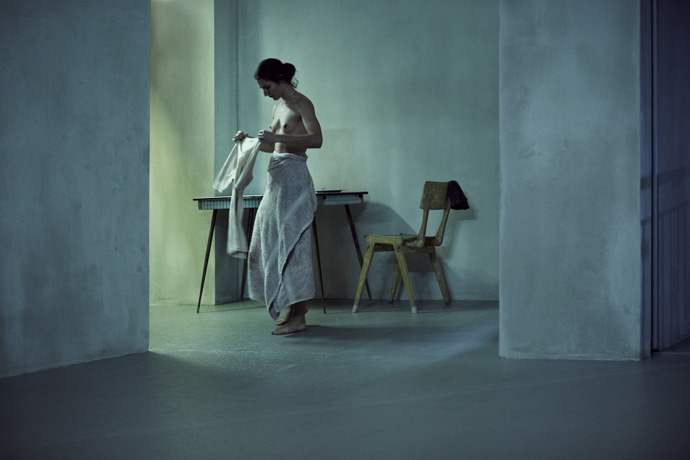
Scene from INSIDE by Dimitris Papaioannou. Photo by René HabermacherWhat you see is a composition, a series of everyday private movements and actions that are exactly the same, repeated multiple times by 30 performers in various overlapping and recycled versions. These phrases come together, then one remains, then another five come into play. It’s about density and overlapping forms. An ongoing open composition that encourages audiences to create their own compositions, depending on how many times, how long and from which angle they choose to see the play.
This is an idea that intrigues me, that people in the centre of the city will visit a theatre to watch others doing things that they do themselves, and the people they watch are themselves watching the city through the window. This is something I feel is charming.
It is these two elements — that of the city documentary exploring a place common to all, and the freedom given to audiences as to how they can view the work — that come together in my view to create this project. The subject of it is one level, the form of it is another, and both are conceived at the same time. This is what interests me, and this is why I am doing it.
So this is what INSIDE is.
I don’t know what people are going to do and how audiences will make use of this game that I am proposing. It’s something of an experiment, we’ll see how it’ll work.
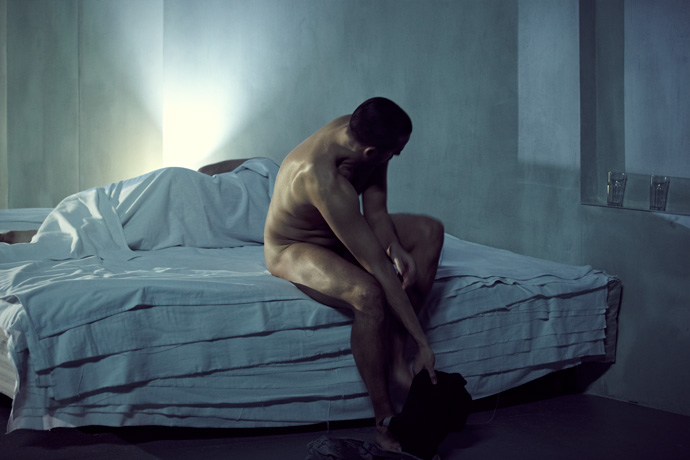
Scene from INSIDE by Dimitris Papaioannou. Photo by René HabermacherIt reminds me of the photographs of Eadweard Muybridge for example, or the performances of Marina Abramović.
Abramović has these elements of patience, and of exhausting the human body. She has done one performance [“The House with the Ocean View”, 2002] where she actually lived in a gallery, in public view, which resembles what I am doing. But my work is not performance art, it requires rehearsal and it will repeat itself everyday; it’s not like an algorithm that evolves organically in front of our eyes. That’s why we are doing it in a theatre and not in a museum or gallery, because it is a kind of a twisted version of a performance, but not performance art. It is something that is rehearsed, that has an acting tone, and is not personal like most performance art, which is about a specific person doing something in that moment. Of course, this experiment of mine would not have been possible if performance art had never existed.
INSIDE reminds you of Muybridge because it gives you the chance to see and imprint in your head the successive stages of a movement, just like Muybridge did in his photographs. They also share the element of observing people: how people move, how they walk.
It’s like filming a documentary in the savannah: you film for hours following a lion and then you have 15 minutes where the lion sits doing nothing. We are taking these 15 minutes of footage of the lion making slight movements and superimposing it many times, through shifts in the timing, to create an entire play out of it. It is still the lion. It’s still about observing the lion. The lion does nothing new. But hopefully we will be magnetised by these successive of layers of the same action taking place, and start meditating upon our own lives.
That was a good example! We are becoming very abstract and intellectual now.
I can’t help it!
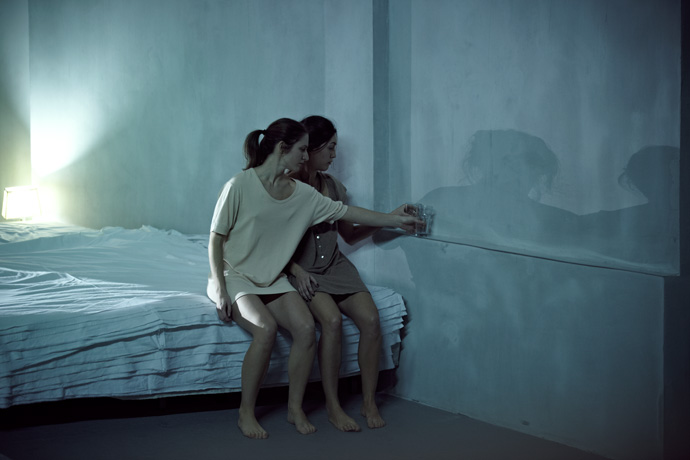
Scene from INSIDE by Dimitris Papaioannou. Photo by René HabermacherI understand that this idea for INSIDE has been in your head for quite a while now.
It was the first thing that came into my head after 2004, the first thing I wanted to do and found worth doing. Back then I had the idea of this room, and of creating a composition from a single simple series of movements by multiplying and superimposing it. Within the framework of a two-hour show, this seemed ridiculous — this limitation would have strangled the idea, forcing the whole thing to have a conclusion, a climax, a very specific story to tell. It would also seem like a joke to audiences, setting them up for something with a beginning, middle and end and then presenting them this thing repeating itself and multiplying, waxing and waning before their eyes, without giving them the chance to leave whenever they want. So I didn’t do it.
Last year, I made the leap in relation to the way the theatre itself could function: I could create a very long show and give people the freedom to come and go as they please. I had to deal with the logistics of the thing, but then suddenly a form was created in which this content could take place. Because once you liberate the audience from having to see it all, then you also liberate the show itself to develop in ways that do not necessarily lead to a defined conclusion. So that is why it is happening now, because it took me some time to conceive the framework within which this could function.
Official trailer for INSIDE.
There are some recurrent elements that I always see on your mood boards, in your work, in your references, and last week I saw a key element once again: the kouros.
Yes!
That one always returns, either standing or fallen.
I deeply apologise, I cannot help it! Some things come back again and again, you know, until everybody will just be exhausted by it and nobody will ever visit anything I do ever again!
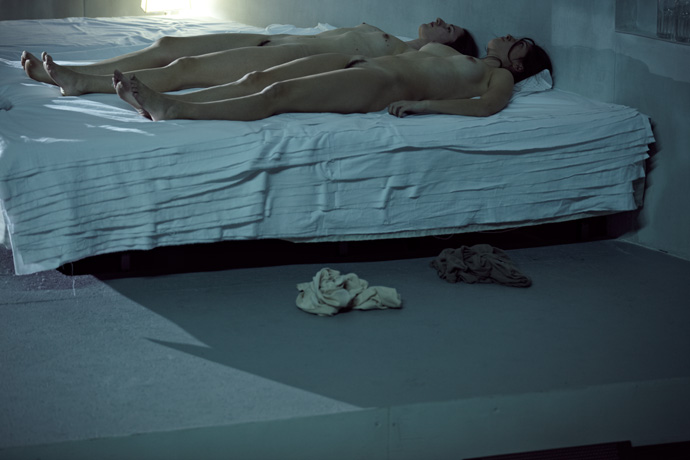
Scene from INSIDE by Dimitris Papaioannou. Photo by René HabermacherWould you say you have an obsession with what the kouros represents: beauty, nobility, youth?
It’s not about youth. It just happens that I work with people who are quite young. I’ve never flinched from the idea of worshipping the structure of a human body: I like the body. I like looking at human bodies. There is something about beauty that charms me and puzzles me and magnetises me.
I have a certain understanding of the human presence, of the human body situated in space and against the vastness of the sky of existence. I usually have people looking at landscapes. I think in every play I’ve done, I’ve had someone looking at something. This is something that maybe comes from me: I tend to breathe things in by looking at them.
When the kouros came to ancient Greece from ancient Egypt, it took one giant step forward: extracted from his background, the axis of his body shifted over his two feet. So for the first time in history, there was a life-size sculpted human figure that could be seen from all sides. And this coincides in ancient Greek history with the dawn of poetry, of lyrical poetry, where people started to talk about how they feel. For me, the kouros is more than a celebration of youth and beauty. I think its more the celebration of wandering. A figure standing on earth, wondering about its own position in space. Wandering in space: where do we stand, where are we? You know, it’s a common puzzle for us humans, and it attracts me. My work reflects that I guess.
Is that enough, dear? Do you want more?! [laughs]
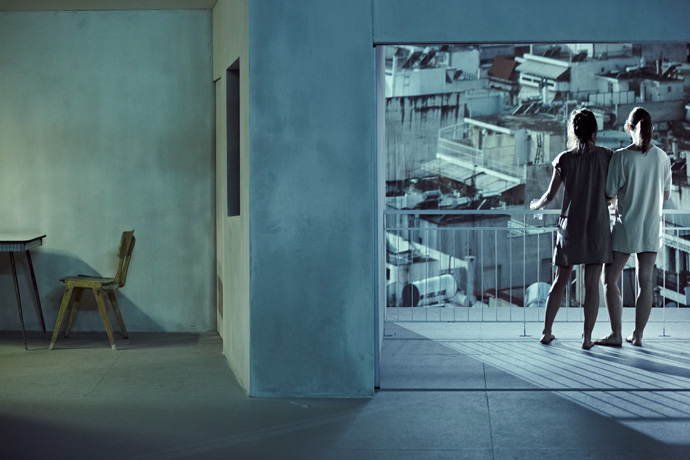
Scene from INSIDE by Dimitris Papaioannou. Photo by René Habermacher -

dimitris papaioannou : spatial and human relationships
-SPATIAL AND HUMAN RELATIONSHIPS
Continuing the conversation with Greek choreographer Dimitris Papaioannou, this second part concentrates on his post olympic work as MEDEA2 and the influences of butoh and his native Athens in his work.
 Scene from MEDEA2 by Dimitris Papaioannou. Photo by René Habermacher
Scene from MEDEA2 by Dimitris Papaioannou. Photo by René HabermacherRENÉ HABERMACHER: Over the years your journey has brought your work to ever-larger audiences. Recently, with your play MEDEA2, you revisited the past. How was that experience?
DIMITRIS PAPAIOANNOU: It challenged me for a number of reasons. If you follow my journey, I was violently exposed to the general public with the success of the Opening Ceremony of the Athens Olympic Games. In order to recover from the experience, I had to take a two-year break.
The first thing I chose to do after this pause was a show called 2. 2 was actually an attempt to pick up where I had left off before the ceremony, to return to my roots and re-evaluate my work. I constructed a very personal show on a large scale because I was offered the opportunity to do so, and I tried to restart my interrupted line of development in an unusual way.
After this experience many question marks arose, and I realised that I was still exposed to a much larger public than I was used to. I had the feeling that there was a new kind of communication being created that was both charming and dangerous. I needed more time before taking my next step.
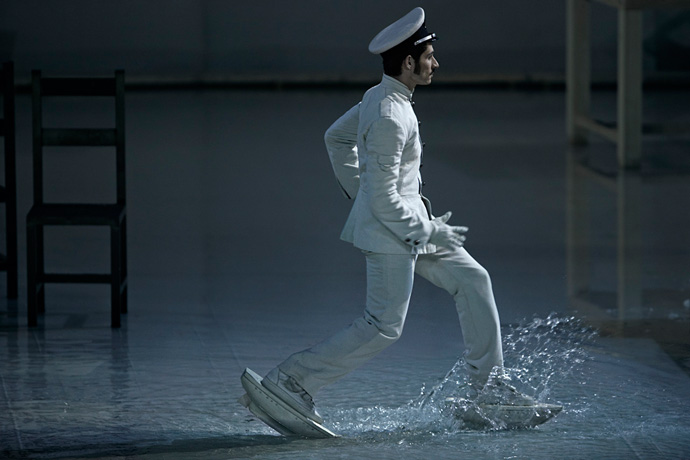 Jason crossing the sea. Scene from MEDEA2 by Dimitris Papaioannou. Photo by René Habermacher
Jason crossing the sea. Scene from MEDEA2 by Dimitris Papaioannou. Photo by René HabermacherMany people were suddenly exposed to my work through the Olympics, but of those who had a real interest, many were too young to have experienced MEDEA. So I returned to MEDEA, attracted by the idea of presenting it again with an all new cast, and approaching it with a new idea: to take the passion out. I wanted to reconstruct it, refine it, clear it out, strip it of anything unnecessary, drain the blood from the performance and deliver it in the cleanest form I could manage. That was my intention with MEDEA2.
Having done that, I could continue with new work, first NOWHERE and now INSIDE. This is a completely new phase, where I am tending to create shows with no protagonists and no characters. The crowd is the element I’m focusing on now, using it in a more open structure in order to create images involving spatial and human relationships.
Excerpts of MEDEA 2 accompanied by interview with Dimitris Papaioannou.
-

dimitris papaioannou : a pasolinian touch
-Dimitris Papaioannou’s work as a choreographer has significantly reshaped the Greek performing arts landscape.
With his directing of the Athens 2004 Olympic Games Ceremony, a ground-breaking success, he played his way straight in the heart of the spectators, hailed a “triumph” by TIME MAGAZINE and THE TIMES of LONDON.In 2005 Dimitris Papaioannou was awarded the Golden Cross of the Order of Honour by the President of the Hellenic Republic for outstanding artistic achievement. For his following shows “2″ and MEDEA2 enjoyed an unprecedented run in the Greek capital, each with over 100 000 tickets sold. This accelerated development came not without controversy. With his latest play INSIDE Dimitris returns to his experimental roots.
THE STIMULEYE met with him during a break of rehearsals in Athens, to speak about his new play and look back to his point of departure.
Following the first part of three on the conversation with Dimitris Papaioannou, accompanied with exclusive pictures by René Habermacher.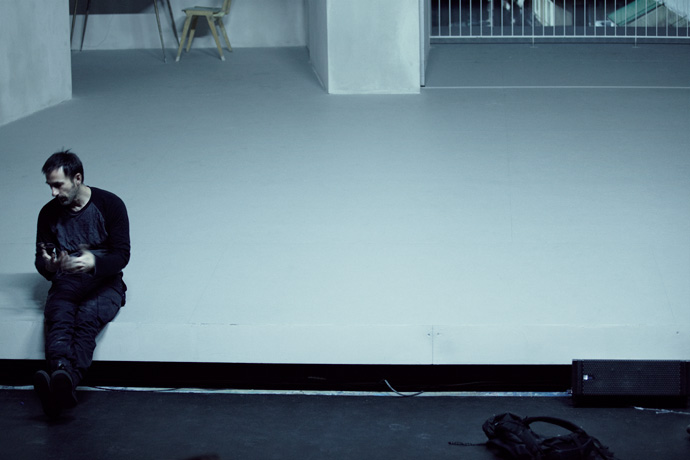 Dimitris Papaioannou on the rehearsal set for his new play INSIDE. Photo by René Habermacher
Dimitris Papaioannou on the rehearsal set for his new play INSIDE. Photo by René Habermacherpasolinian touch
DIMITRIS PAPAIOANNOU: I’ll be right with you — I’m just making a coffee!
RENÉ HABERMACHER: You’re freshly shaven! You look very 19th-century with your moustache.
I am from the 19th century honey, I’m very old!
It’s been a while since we had time for a talk, since I left Athens and you last visited Paris. We met only briefly during the rehearsals for your new play INSIDE, which you’re currently working on. You spent last Spring in New York. Tell me about what you did there.
I was there from March until June on a Fulbright Artist’s Scholarship. A mid-career scholarship obviously… [laughs]
Actually in a way I was studying the story of performance art [with Laurie Anderson at The Kitchen NYC] and developing my Final Cut Pro skills, as well as experiencing a little more of New York life, now that I’m a mature boy and things are different!
How was it returning to Athens after that?
For me it was a blessing because I discovered that I had left New York when I was still under construction. It’s the perfect place to be when you are like that, but in this phase of my life what I found there was a little more superficial than I would have liked. The Athens I returned to was in complete economic crisis and emotionally depressed, but still I was deeply relieved to spend summer back home.
Dimitris, I know you were born in Athens, but we’ve never talked about your childhood.
I was born and grew up in Athens, in a lower-middle class family. My parents made financial sacrifices so that I could go to a very expensive school, the Athens College. Then I had to run away from home because my parents wanted me to live the life of a straight architect. But I was a gay man, and I wanted to be a painter. I became the student of the Greek painter Yannis Tsarouchis* (1) in the old fashioned way, where painters trained people in their atelier. It was there I was introduced to true art. I had been painting since I was a child, but it was when I met Tsarouchis that I realised what painting really was. Later I entered the Athens School of Fine Arts.
* (1) : Yannis Tsarouchis, 1910-1989 One of the most important twentieth-century Greek painters, Yannis Tsarouchis portrayed and helped to define modern Greek identity. The deeply sensual painter was much influenced by the French impressionists and often depicted sailors, soldiers and the nude male body in erotic situations.
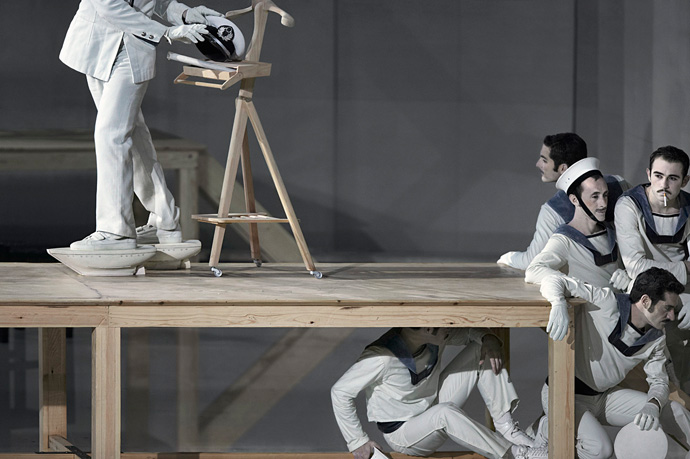 The departure of Jason in reference to Yannis Tsarouchis. Scene from MEDEA2 by Dimitris Papaioannou
The departure of Jason in reference to Yannis Tsarouchis. Scene from MEDEA2 by Dimitris PapaioannouHow did you meet Tsarouchis?
I knocked on his door. I showed him some my paintings and asked for his comments. He was not cruel, as he could have been, about those awkward early drawings — instead he was very polite. My college had organised an exhibition of my work in the building’s library, so I invited Tsarouchis to see my work up close. The next day he called me and invited me back to his house, after which he allowed me to watch him paint, and would give corrections on my paintings. I became his student.
How did this encounter shape you? Did it leave a mark on your artistic work?
Well, your first mentor leaves a strong mark on your life. I grew up in a house that had no contact with artists, there wasn’t a single painting on the walls. My parents weren’t very fond of art, it wasn’t part of their lives. I felt like an alien, wanting to enter this world. So Tsarouchis was the first artist I really saw working, and I realised that the life of an artist is possible and, to my eyes, very charming. I felt at home in a way. And he was a great painter. He had a quality that interests me a great deal: he could make magic with the humblest of materials — he could make roses out of toilet paper, use wires to make small sculptures. The thing I think I have learned from him is that you can make poetry out of garbage.
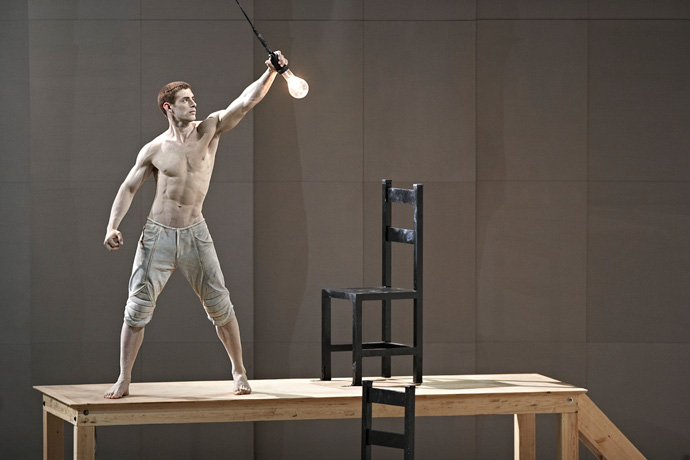 “Helios”. Scene from MEDEA2 by Dimitris Papaioannou. Photo by René Habermacher
“Helios”. Scene from MEDEA2 by Dimitris Papaioannou. Photo by René Habermacher
